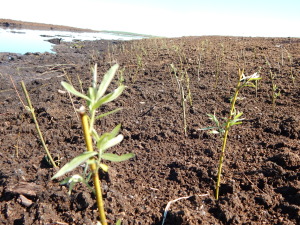For the past three winters, APT has been exploring an alternative way of harvesting peat. Normally, we harvest peat by drying the peat surface throughout the summer, and pushing the drier material into windrows. Then, once winter comes and we can put in roads across the harvest area, those windrows are transferred to the production plant. Starting in 2013, however, we tested the concept of excavating the full section of the peat deposit. There are a number of different reasons why excavation is a good business alternative, but we’re now beginning to realize the additional benefits to wildlife.
 At its simplest, excavation creates a pond. Because APT will never harvest peat from that particular spot again, we can start to reclaim the peatland in a process called staged restoration. Three months ago, the banks of the pond were shaped into gentle slopes, and we started planting live stakes of willow and dogwood. The willows are now leafing out and giving a green surface to the shore, and some native vegetation is starting to volunteer along the water’s edge. A portion of the bank received a layer of donor soil and that transplanted soil is now greening up and sending down roots. Later this spring, we will broadcast seeds on the other slopes and install flats of emergents at the water’s edge. Over time, the shrubs and emergent and upland native plants will provide habitat for a variety of insects, birds and mammals.
At its simplest, excavation creates a pond. Because APT will never harvest peat from that particular spot again, we can start to reclaim the peatland in a process called staged restoration. Three months ago, the banks of the pond were shaped into gentle slopes, and we started planting live stakes of willow and dogwood. The willows are now leafing out and giving a green surface to the shore, and some native vegetation is starting to volunteer along the water’s edge. A portion of the bank received a layer of donor soil and that transplanted soil is now greening up and sending down roots. Later this spring, we will broadcast seeds on the other slopes and install flats of emergents at the water’s edge. Over time, the shrubs and emergent and upland native plants will provide habitat for a variety of insects, birds and mammals.
 Even though the banks are only sparsely vegetated so far, the pond itself is already home to aquatic insects and schools of minnows that are using the irregular bottom substrate for cover and feeding. Butterflies are using the muddy flats for puddling. Swallows skim over the surface foraging for food. Killdeer cry and feint at the sight of an intruder. Sandpipers and plovers loaf and feed on the muddy shoreline during their spring migration. Earlier in the spring, swans and ducks rested on the shallow water of the pond between feeding forays into neighboring fields. These species were not evident before the pond was excavated. They are proof that that staged restoration will provide a continuous and slowly evolving landscape that wildlife will use for a variety of uses. The ultimate goal, of course, is to return the harvest area to a peat-producing wetland. In the meantime, the expanding pond will provide cover, food and space for a variety of species that will thrive in the newly-created opportunities.
Even though the banks are only sparsely vegetated so far, the pond itself is already home to aquatic insects and schools of minnows that are using the irregular bottom substrate for cover and feeding. Butterflies are using the muddy flats for puddling. Swallows skim over the surface foraging for food. Killdeer cry and feint at the sight of an intruder. Sandpipers and plovers loaf and feed on the muddy shoreline during their spring migration. Earlier in the spring, swans and ducks rested on the shallow water of the pond between feeding forays into neighboring fields. These species were not evident before the pond was excavated. They are proof that that staged restoration will provide a continuous and slowly evolving landscape that wildlife will use for a variety of uses. The ultimate goal, of course, is to return the harvest area to a peat-producing wetland. In the meantime, the expanding pond will provide cover, food and space for a variety of species that will thrive in the newly-created opportunities.
Using peatlands to create value-added products with environmental and economic significance means, by definition, that the peatland itself will be disturbed and harvested. There is no doubt that intact bogs and fens are a striking part of the landscape. But the reclamation of a harvested peatland can be just as stunning, as our restoration project is demonstrating. Stay tuned to see the story unfold.
